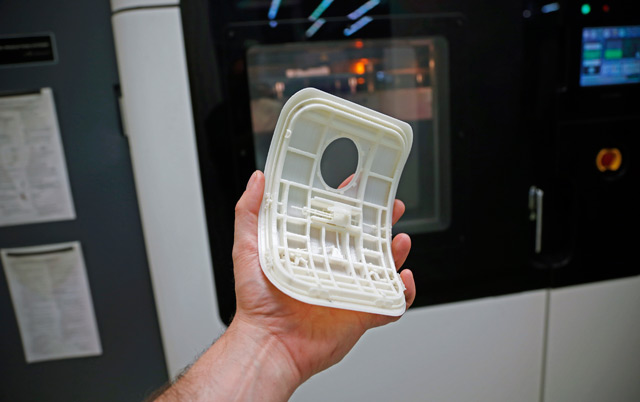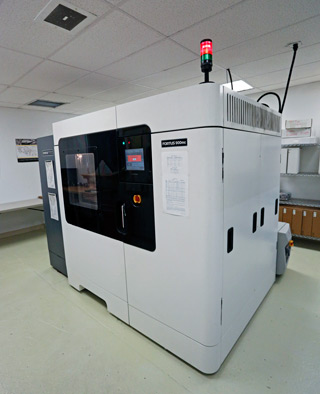Technology: Control+P
3-D printing brings opportunity to aerospace

Piper’s 3-D printer is used mostly for tooling and test pieces, such as this door model for the now-defunct Altaire.
The past decade has seen incredible innovation in avionics and associated computer hardware. Airframes and interiors have remained largely stagnant, thanks in part to the huge development costs and relatively low payoff.
That may all be changing because of the adoption of 3-D printing.
3-D printing, sometimes described as rapid prototyping, is a revolutionary technology that has the potential to bring about less expensive aircraft products, innovative new designs, and a broader spectrum of equipment options for owners—all because of a simple concept that makes it easier to get ideas from an engineer’s head to production faster and cheaper. Much like an inkjet printer, most 3-D printers use an additive process that lays a molten material in layer upon layer to build any three-dimensional object the user wishes to create. Typically an engineer creates an object in a design program such as CAD, and then sends the file to the printer, which goes to work automatically. What comes out can be anything from jewelry to a bicycle to turbine fan blades.
The technology has been around since the 1980s, and used by Formula 1 racing and others since at least the 1990s. Aircraft manufacturers such as Piper and Cirrus have added it into the engineering and testing process over the past few years as printer prices have come down. Jeremy Henriksen manages the experimental department at Cirrus, and he says the company has used 3-D printing for a number of programs. “We see it as a tool for rapidly prototyping parts,” he said. Take the example of a new wingtip light. Previously, Henriksen said, the engineer would design the housing and then have it sent out to a vendor to make a one-off test piece. That process would take a month or more and come at a premium cost. With the 3-D printer the engineer can design the part, create a prototype that day, and it can be fitted to the airplane and possibly test flown the next day. The only cost would be a small amount of time and some minor costs for materials. 
According to Piper’s Lou Ciarlelli, the material costs about $5 per cubic inch. Ciarlelli runs Piper’s 3-D printer, which is primarily used for tooling and interior parts. Creating permanent tool and die can be very expensive for a manufacturer, so the option to invest only $500 on a throwaway mold is pretty helpful when developing new forms. Piper also has created new interior parts, environmental ducting, and overhead panels with the printer.
Creating cheaper and faster prototypes means engineers are able to take more chances with their designs. “It has made them proactive with trying new things,” Ciarlelli said. And the fact that Cirrus houses the printer in the experimental department shows how the company views the impact of the technology. “It can help to understand how a part is manufactured while it’s being designed,” Henriksen said. “In an airplane program, that step could otherwise be years in the future.” The cost savings and reduced time to market definitely matter with manufacturers, but given the variety of products and depth of resources, 3-D printing is just one of many technologies that can help.
For a boutique manufacturer of products for the STC market, 3-D printing can be the difference between surviving or not. AeroVoodoo President and CEO Michael McConnell said anything you can do to reduce the time to market is critical. McConnell, who formerly served as CEO of Eclipse Aviation, gives the example of a simple aerodynamic modification. Let’s say the start-up company has budgeted 18 months to design, develop, and certify the modification. Under normal circumstances it may take all that time to simply design the part, have a test piece manufactured, and then test-fly it. But with 3-D printing that timeframe could be shortened by six months, leaving more time for the paperwork to sit with the FAA, as he said it usually does. That’s six months faster to revenue.
McConnell said 3-D printing also has the potential to bring a greater variety of products to the market. If the company can start making money faster, and spend less on development, the market size doesn’t need to be as large. So instead of having to sell 100 units, a business may have to sell only 50. That’s good news for owners of less common aircraft, as small shops could start popping up to offer much needed modifications and replacement parts.
Homebuilders ultimately could benefit the most from 3-D printing. All an owner potentially has to do is design a brand-new part, send the file to a 3-D printing shop, and a short time later it would come in the mail. All of this is considerably less expensive than having a company fabricate something new from steel or fiberglass. Good consumer-grade printers are coming on the market at a reasonable price. It’s not crazy to think that a builder would buy one specifically for the build process and to modify parts.
There are drawbacks, of course. Only a few of the materials are able to pass FAA burn certification. While any 3-D printing material could potentially be as good as a tool or die, only a few can be used inside an airplane. And as with any material, there are inherent weaknesses. The failure points must be known and respected for a homebuilder to use it properly. It’s also one reason why manufacturers don’t see the option of producing 3-D parts on any sort of large scale. The other is cost. The technology is often referred to as rapid prototyping because that’s what it’s best used for. Once the part is ready to manufacture, it’s often much more economical to make a mold or use other traditional methods.
That said, the possibilities are just now being explored. There are 3-D-printed jet engines for radio-controlled airplanes, college undergraduates creating 3-D-printed remote-control airplanes for the Department of Defense, and even GE is using it in the development of new engines. Custom-fitted seats, perfectly sculpted aerodynamic mods, better cockpit layouts, and more all are possible and probable if we just hit Print.
Email [email protected].


